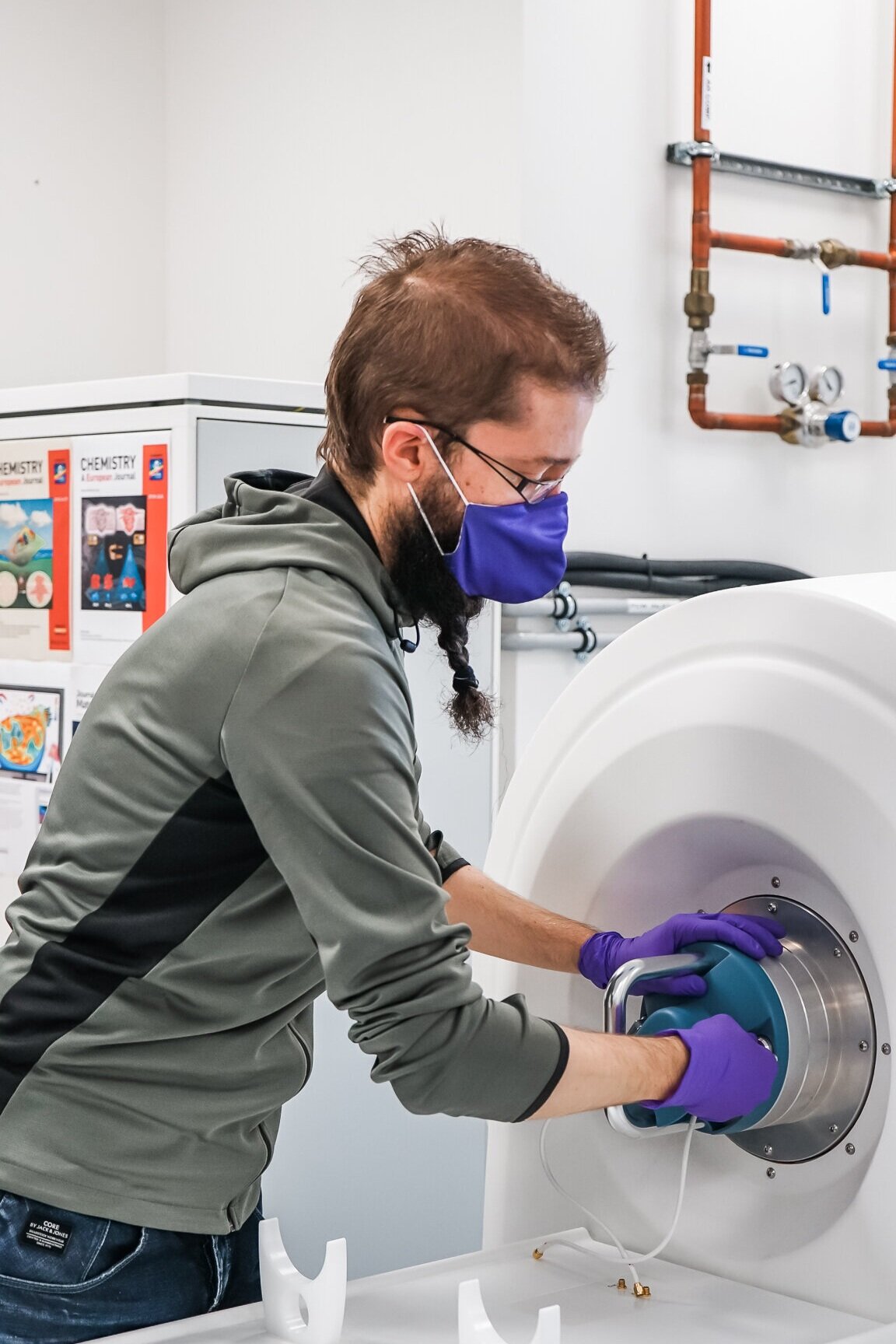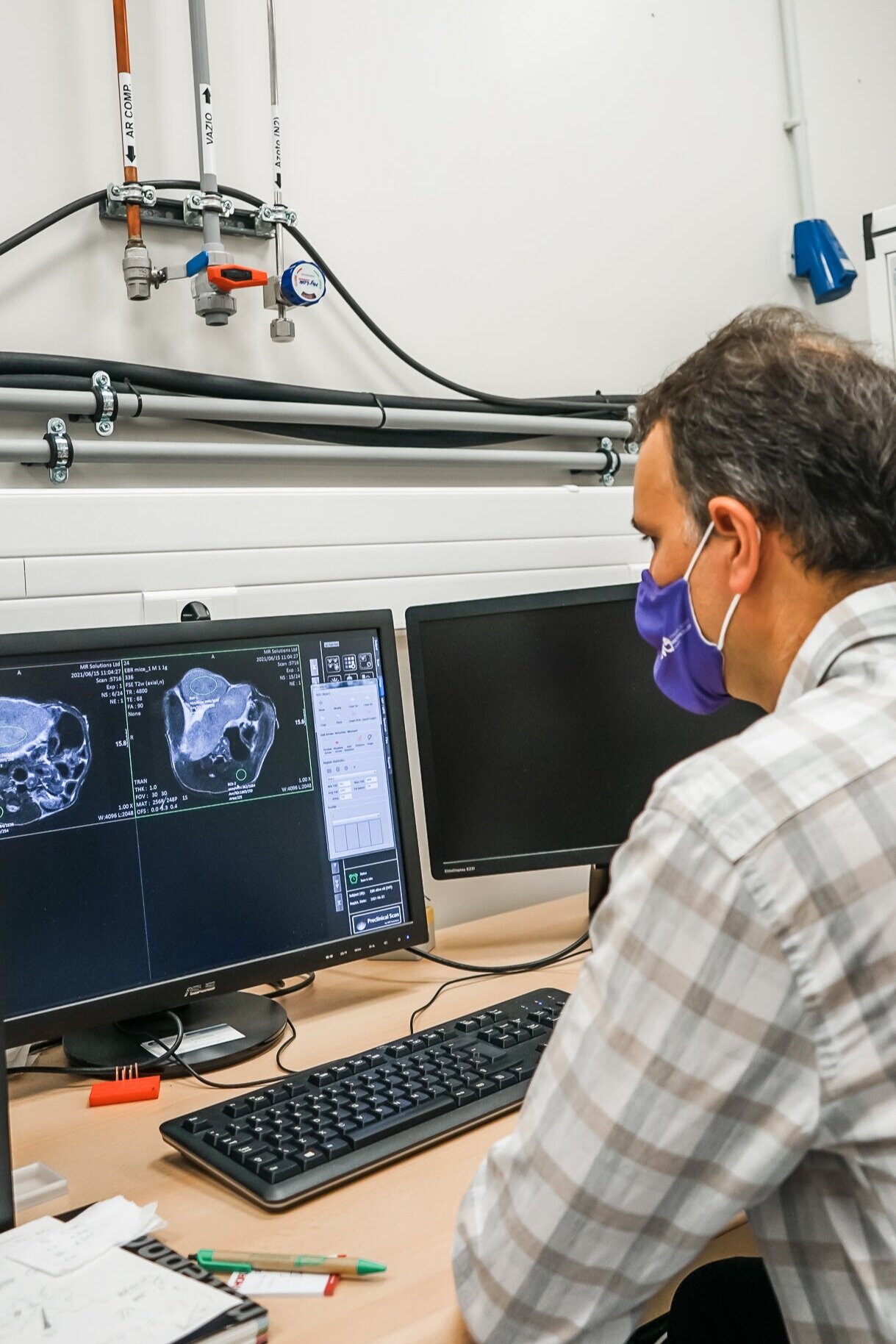
Developing innovative solutions that address current clinical challenges, an interview Manuel Bañobre-López
October 7, 2021
Manuel Bañobre-López (MB) graduated in Chemistry from the University of Santiago de Compostela and obtained his PhD degree in Solid State Chemistry from the same University. He has been a research visitor in the University of Texas at Austin, and in 2011 he joined as postdoctoral researcher the International Iberian Nanotechnology Laboratory at Braga (INL), Portugal, where he currently leads the Nanomedicine Group and the Advanced (magnetic) Theranostic Nanostructures Lab (AmTheNa).
Manuel Bañobre’s research group focuses on the engineering of multifunctional magnetic hybrid nanoparticles as nanomedical platforms for theranostic applications, mainly focused on disease-targeted non-invasive imaging diagnosis and magnetically-assisted therapies. His group has provided significant contributions to the relationship between the structural and magnetic properties of nanoscale transition metal oxides and their functional performance in the biomedical field.
At INL since 2011, how was your journey before arriving here and what were the most important projects you’ve worked in?
I graduated in Chemistry from the University of Santiago de Compostela, Spain. Then I started my PhD in Solid State Chemistry, where I worked under the supervision of Prof. Francisco Rivadulla in the synthesis and characterization of the chemical, magnetic and electric properties of NaxCoO2, a trending material at that time due to its structural similarities with LixCoO2, a compound widely used in the batteries of today. This material shows a very rich magnetic and electronic phase diagram and becomes a superconductor below 5K for specific sodium contents, which made it a very promising material to get new insights on the fundamental understanding of superconductivity, as well as in its technological applications in energy harvesting.
In the framework of this research, I had the opportunity to be a visiting researcher in the laboratory of Prof. J. B. Goodenough, who was Nobel laureate in Chemistry in 2019 for his discoveries on rechargeable lithium-ion batteries. Also encouraged by the interdisciplinary character of my host research group in Santiago de Compostela, during my PhD I could also engage in projects related to fundamental and applied aspects of magnetic nanoparticles. Thus, I participated in several projects involving the study of synthesis-structure-property correlations in metal transition oxide nanostructures and derived functional magnetic materials for biomedical applications, i.e. advanced functional nanostructures and magnetic scaffolds for magnetic hyperthermia-induced drug delivery and bone tissue regeneration, framed within an FP7-EU funded project that led to relevant patents and scientific publications.
Once at INL in 2011, this expertise was applied to the development of innovative functional materials for advanced biomedical imaging and disruptive therapies, mostly powered by a magnetic component. In these fields, our group has led and participated in several European, regional and national projects that involved the development of magnetic formulations to address identified clinical needs in oncological, neurological and autoimmune diseases, such as:
-
EU–PANA – Promoting active ageing: functional nanostructures for Alzheimer’s disease at ultra-early stages;
-
2IQBIONEURO – Fostering an R&I network in biological Chemistry for diagnostic and treatment of neurological diseases;
-
MagTargetON – Local specific treatment of triple-negative-breast-cancer through externally triggered target-less drug carriers;
-
NANOTHER – TAM’s targeted and externally controlled nanotheranostics of triple-negative-breast-cancer;
-
SELF-I – Self-reporting immunostimulating formulation for on-demand cancer therapy with real–time treatment response monitoring;
-
UnTAM – Unleashing the tumour-associated macrophage (TAM) workforce to fight against cancer from the inside;
-
RTChip4Theranostics – Real-time Liver-on-a-chip platform with integrated micro(bio)sensors for preclinical validation of graphene-based magnetic nanocarriers towards cancer theranostics;
-
MSCA – BrainChip4MED – Brain-on-a-chip as a preclinical model tool for the screening of theranostic nanoformulations for neurodegenerative diseases), among others. Some of them are still ongoing and all have contributed to the fundraising of > 2 M€.
How did the Nanomedicine Research group start and how does the group correlates with INL’s Research Strategy?
It has been a long way to get here. In the last decade, the Nanomedicine group (NM) has built on fundamental aspects of material science and progressively moved to the biomedical field, as a final target were to demonstrate the applicability of our developed functional nanomaterials.
Currently, NM’s research focuses on the development of diagnostic and therapeutic approaches towards an early and unequivocal diagnosis and treatment of diseases with a strong focus on cancer and inflammatory conditions. NM explores new concepts and paradigms in the medical field through genuine research taking place at the frontiers of knowledge, aiming at overcoming current clinical needs and defeating new challenges to global health. To this aim, starting from a fundamental understanding of disease and biological pathways, NM applies cross-disciplinary research focused on the development of technologies and effective nanoparticles-based formulations for precision disease diagnosis, therapy and theranostics, ranging from low to medium technology readiness levels (TRLs).
All the NM research activities are well framed within the Precise Personalized Health Tech Cluster at INL and its two missions, Precision Medicine and Advanced Models of Disease, which aim at developing nano-enabled medical solutions that allow prevention, earlier diagnosis and personalised treatment with fewer side effects, aided by more robust and relevant models of disease that allow accelerating therapy testing and technology transfer. NM group brings together chemists, biochemists, biologists and pharmacists in a multi- and inter-disciplinary approach, looking for synergies all the way along the value chain, from early design and development stages to technology transfer phases where strategic partnerships are established with relevant companies and collaborators.
Briefly, what do you enjoy about your work and how do you see your research developments in the near future?
I would say that one of the things that I enjoy the most is the opportunity to create, innovate and explore new concepts and ideas with the potential to push on the state-of-art in the area of nanotechnology and nanomedicine.
The possibility to go deeper in the fundamental understanding of chemical and physical properties of nanomaterials, build on them to develop innovative solutions that address current clinical challenges and eventually generate suitable products for the benefit of society…that’s actually great. The proximity with other disciplines and the international environment at INL is undoubtedly a very beneficial asset of my work from both personal and professional perspectives.
Regarding the future, our research group strategy settles on the combination of fundamental and applied research for the design of functional nanostructures that aim at radically improving the management of a certain disease condition. Although we have been pretty much focused on cancer, we intend to expand our knowledge and explore other types of serious conditions where our contribution can become a ‘game changer’.
We will definitely continue improving our formulations and strengthening our technology transfer capabilities to materialize this excellent research in real solutions for the access of all.
Manuel Bañobre-López and Juan Gallo shared the latest developments of their work in an interview in the Portuguese national television – SIC Noticias.







